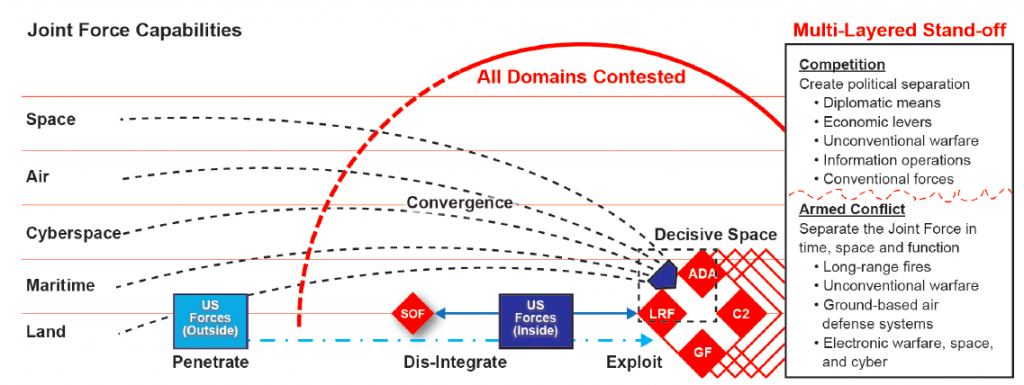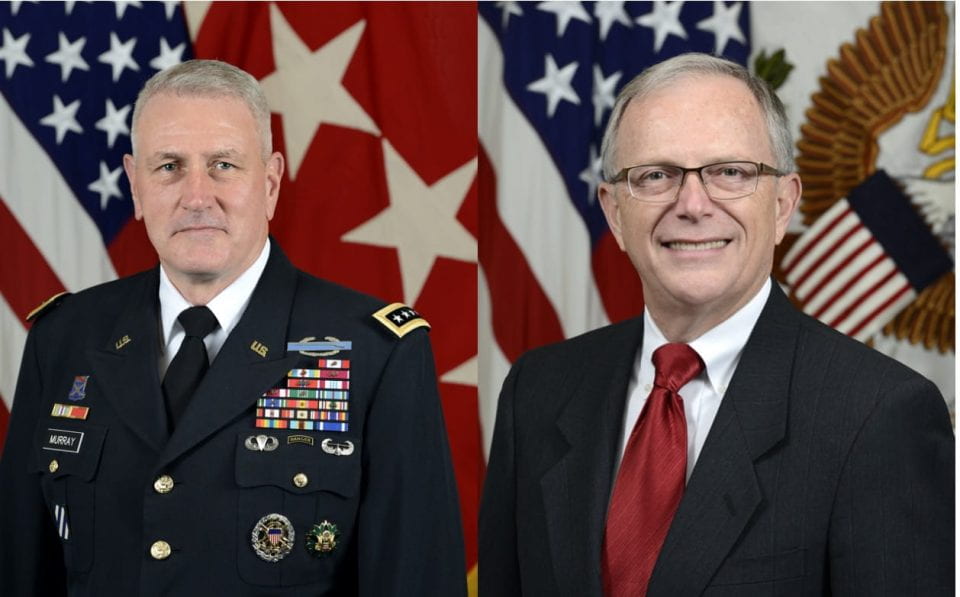
SOURCE: Army Multi-Domain Operations Concept, December 2018.
WASHINGTON: Damn the pandemic, full speed ahead. The four-star chief of Army Futures Command plans to hold a high-tech field test in the southwest desert this fall, COVID-19 or no.
Called Project Convergence, the exercise will test sharing of targeting data amongst the Army’s newest weapons, including aerial scouts, long-range missile launchers and armored vehicles. The Army also wants to plug in its new anti-aircraft and missile defense systems, AFC head Gen. Mike Murray told reporters, but those technologies are at a critical juncture in their own individual test programs – some of which was delayed by COVID – and they may not be ready on time for this fall.
“I’m going to try to drag them all into this,” Murray said. The experiment, set to begin in late August or early September, will definitely include the Army’s Artificial Intelligence Task Force, as well as four of its eight modernization Cross Functional Teams. That’s Long-Range Precision Fires (i.e. artillery), Future Vertical Lift aircraft (including drones), and the tactical network, he said, plus the Next Generation Combat Vehicle team in “a supporting role.”
What about the Air & Missile Defense team? “We’ll see,” Murray said. “Right now… I’m very cautious, because of the two major tests they’ve got going on this fall in terms of IBCS and IMSHORAD.” IBCS is the Army’s new command network for air and missile defense units, which had to delay a major field test due to COVID. IMSHORAD is an 8×8 Stryker armored vehicle fitted with anti-aircraft missiles and guns, which Murray said is now delayed “a few months” by software problems.
Meanwhile, the Air Force – with some input from the other services – will be testing its own nascent data-sharing network. That’s the ambitious Advanced Battle Management System, the leading candidate to be the backbone of a future Joint All-Domain Command & Control (JADC2) network-of-networks linking all the armed services.
The Air Force’s ABMS experiment will be separate from the Army’s Project Convergence exercise happening at roughly the same time this fall, Murray said. But he wants to hold a Convergence test each year from now on, he told reporters, and he wants to bring in ABMS in 2021.
“In ’20, we’re parallel, not interconnected,” he said. “Our desire is to bring them closer and closer together, beginning in ’21.”
Sensor To Shooter
Murray spoke via phone to the Defense Writers Group, along with the Army’s civilian chief of acquisition, Bruce Jette. While the two men’s roles and organizations are kept distinct by law, they’ve been joined at the hip on modernization, and Jette – a scientist, engineer, and inventor — is clearly enthused about the experiment.
“We are looking at the potential integration of all of our fires into a fires network,” Jette told the listening reporters. Currently, he explained, the Army has one network, AFATDS, to pass data about ground targets to its offensive artillery units – howitzers, rocket launchers, surface-to-surface missiles. Meanwhile, it’s developing a different network, IBCS, to share data on flying targets – incoming enemy rockets, missiles, and aircraft – amongst its air and missile defense units.
The two networks and the sensors that feed them must meet very different technical demands, since shooting down a missile requires split-second precision that bombarding a tank battalion does not. But there’s also great potential for the two to share data and work together. For example, the defensive side can figure out where enemy missiles are launching from, then tell the offensive side so it can blow up the enemy launchers before they fire again.
“If I can bring the two of them together,” Jette said, you can use a sensor the Army already developed, bought and fielded to spot targets for one weapon – say, the Q-53 artillery radar – to feed targeting data into a totally different type of weapon – say, a Patriot battery. Artificial intelligence could pull together data from multiple sensors, each seeing the same target in different wavelengths or from a different angle, to build a composite picture more precise than its parts.
“We’re moving past just simple concepts of sensors and shooters,” Jette said. “How do we get multiple sensors and shooters [integrated] such that we get more out of them than an individual item could provide?”
Looking across the Army’s 34 top modernization programs, Murray said, “an individual capability is interesting, but the effect is greater than the sum of the parts. There have to be connections between these [programs]. And that’s really the secret sauce I’m not going to explain in detail, ever.”
Testing, Testing
What Murray would share, however, was that the Army got to test a slightly less ambitious sensor-to-shooter link in Europe earlier this year, as part of NATO’s Defender 2020 wargames. The field experiment fed data from a wide range of sources – in space, in the air, and on the ground – to an Army howitzer unit, he said.
However, the Army had also wanted to experiment with new headquarters and organizations to command and control ultra-long-range artillery, Murray said, and those aspects of the massive exercise had to be cancelled due to COVID. The service is looking at alternative venues, such as its Combat Training Centers, but “it’s just hard to replicate what Defender 2020 offered us,” he said. “What we lost was the largest exercise we’ve done and the largest deployment of forces in a very, very long time.”
That makes the stakes even higher for Project Convergence. “You can call it an experiment, you can call it a demonstration,” Murray said. “Right now, the plan is we’re going to do this every year… every fall as we continue to mature… this architecture that brings the sensors to the right shooter and through the right headquarters.”

ABMS construct
While this year’s Convergence exercise will focus on the Army, Murray is already working with the Air Force to meld the two next year. “We have been in discussion with the Air Force for the better part of the year on how we integrate with the effort they have going on,” he said. “I was actually out at Nellis the last time they had a live meeting on JADC2 [Joint All-Domain Command & Control] with all of the architects of ABMS.”
Those discussions made very clear to both the Army and the Air Force participants that “it all comes down to data and it all comes down to the architectures you build,” Murray said.
“As Bruce [Jette] talked about, it’s not a specific sensor to a specific shooter,” he said. “On a future battlefield… just about everything is going to be a sensor. So how you do you store that data and how do you enable a smart distribution of data to the right shooter? Because we can’t build architectures that are relying upon huge pipes and just massive bandwidth to make it work.”
Original article can be found here.




